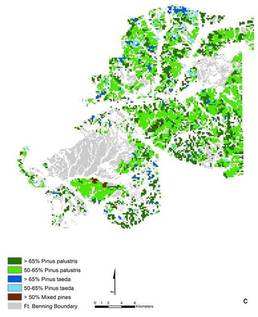|
In our most recent paper, led by Katie Martin, we simulated the effects of different forest management actions on the provision of Red-cockaded Woodpecker (RCW) habitat and carbon sequestration and storage at Fort Benning, GA. The RCW is a federally protected species and Fort Benning is one of the core recovery sites in the recovery plan developed by the US Fish and Wildlife Service. The RCW preferentially nests in longleaf pine trees greater than 60 years old. Something that is in short supply in the southern pine belt since we converted much of the longleaf pine forests to plantation forests. At Fort Benning, they have been restoring longleaf pine forest to provide habitat for RCW and other species that are dependent on this forest type. Longleaf pine forest is a fire-dependent system, meaning that frequent fires in part maintain its structure and function. With funding from the Department of Defense's Strategic Environmental Research and Development Program we investigated how different forest conditions and management actions (restoring longleaf pine forest, prescribed burning, fire-exclusion) influence the development of RCW habitat and the resultant effects on carbon sequestration and storage. Using field data and the simulation model LANDIS-II we found that by actively restoring longleaf pine forest and regularly managing with fire, we can substantially increase the amount of forest that provides RCW habitat. However, this restoration comes at the cost of reduced carbon storage. Without regular fire, these pine forests transition to broadleaved forests (mostly oak species) and do not provide much RCW habitat, but do store more carbon. The map on the left shows the landscape after 100 years without active fire management or longleaf pine restoration. The map on the right shows the landscape with active longleaf pine restoration and regular prescribed burning. The areas of the maps that are green are the areas that provide forest habitat suitable for the RCW. Longleaf pine restoration and regular prescribed burning increase available habitat to approximately 92% of the landscape.
When we looked at the effect of these management options on carbon, we found that substantially increasing RCW habitat requires about a 22% reduction in carbon storage at the end of the 100-year period when compared to excluding fire from the landscape. We also need to consider how much carbon is being removed from the atmosphere each year by tree growth and how much is being emitted to the atmosphere from prescribed burning. We found that the balance of the carbon removed versus emitted was higher over the 100-year period when we actively restored longleaf pine forest. The importance of this finding is that while burning does return carbon stored in the forest to the atmosphere, regrowth by trees and plants quickly recaptures that carbon. In short, our findings demonstrate that providing RCW habitat does require a reduction in the amount of carbon stored in the forest. However, that reduction is not as large as we would expect given how frequently longleaf pine forests need to burn.
2 Comments
Wade Harrison
9/2/2015 01:43:02 am
Beautiful work, thank you. Does the "100 years of no fire management" simulation include effects of wildfire (whose increased likelihood might even be estimated based on the more recent study of Fort Benning's fire program just published)? If not, how might this affect the carbon analysis?
Reply
Matt Hurteau
9/2/2015 02:16:50 am
Thanks Wade. That is a great question. We purposefully excluded wildfire from the control simulation because we wanted to quantify the carbon stock potential in the absence of fire and management. One of the challenges with including wildfire in simulations that exclude management is that we are lacking information about fire behavior in the closed-canopy, broadleaved forest. The carbon outcome of including some probability of wildfire in the control simulations would depend on fire behavior and fire effects. We did run some additional simulations with wildfire over a shorter time horizon that weren't included in the paper. They had the effect of driving down total ecosystem carbon in the control. However, the range of variability was substantial. With some of the on-going empirical work in this system, I'm hopeful we will be able to better incorporate fire in the simulations that exclude management.
Reply
Your comment will be posted after it is approved.
Leave a Reply. |
Details
Archives
October 2023
Categories
All
|




 RSS Feed
RSS Feed